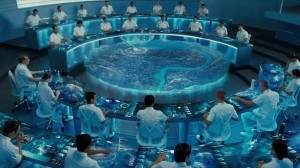Forgive me for not staying up on the (social) science behind Computer Supported Cooperative Work (CSCW), but I remember it being very interesting in 2000. It was hot! Everywhere you turned in my beloved field of Human Factors (or in this case, my much loved cousin Human-Computer Interaction) researchers were examining how to augment human performance with things like shared collaboration spaces and live chat. But, at the time, it seemed that the imaginative future state wasn’t much better than the most popular online bulletin boards and IM clients of that time.

Now, we are in a new age of possibility. Just look at the fantastic CSCW shown in The Hunger Games. The “game” management control room use case is a great example of integration and visualization — taking the many huge data streams that make up an environment, meshing them with the protocols created by your team members, and allowing the entire interaction to be supervised and directed by the Gamemaker. This is an illustration of seamless collaboration and unobtrusive augmentation of human performance. Beautiful.
Of course, I want this technology for selfish reasons. I dream of a day that I can visualize my research’s progress to completion (much like when the technician was building the “wolf mutts”) and make minor corrections with a few keystrokes or gestures.

Once I turn my attention from that, I can see how my research is working in concert with the rest of my team — other user researchers, market researchers, analytics, customer support and sales — to build our organization’s decision simulation ecosystem. Crazy? I hope not.
